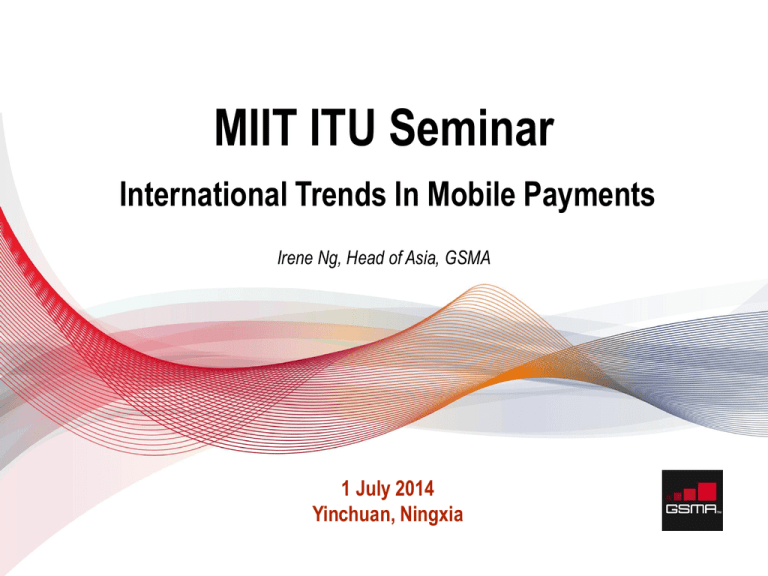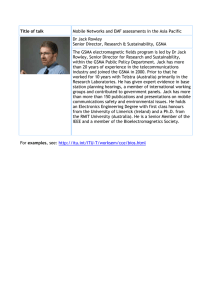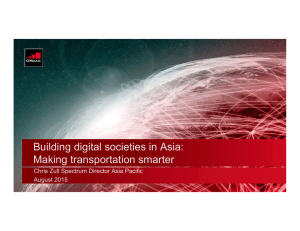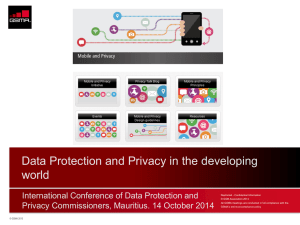MIIT ITU Seminar International Trends In Mobile Payments 1 July 2014 Yinchuan, Ningxia
advertisement

MIIT ITU Seminar International Trends In Mobile Payments Irene Ng, Head of Asia, GSMA 1 July 2014 Yinchuan, Ningxia © GSMA 2013 Role Of The GSMA WE ARE THE GLOBAL INDUSTRY VOICE SHAPING THE FUTURE OF MOBILE INDUSTRY FORUM POLICY ADVOCATE MARKET THINK TANK BUSINESS CATALYST Enabling industry collaboration and consensus Promoting policies that foster growth and investment Delivering insight and analysis from global industry data Serving the global mobile ecosystem through events such as Mobile World Congress and Mobile Asia Expo © GSMA 2013 A Changing Mobile Environment Continued growth of mobile communications in APAC Source: The Mobile Economy Asia Pacific 2014, GSMA, June 2014 © GSMA 2013 A dynamic ecosystem of new business models The mobile internet is at the heart of a dynamic ecosystem of innovation reaching beyond operators: device manufacturers, network infrastructure vendors, content providers, and others. © GSMA 2013 Source: The Mobile Economy Asia Pacific 2013, GSMA BCG, June 2013 Shift towards a more connected lifestyle … Increasingly fast connection speeds allow each user to consume more data. This has led to changes in consumer lifestyle and a more digitally savvy society – to the extent that global consumer expense on ICT reached US$ 2.14 trillion in 2012 and is expected to reach US$ 2.88 trillion in 2016. Source: The Mobile Economy 2013, GSMA/AT Kearney, February 2013 © GSMA 2013 Increasing use of applications … We are already seeing a shift in the handset market and the growing importance of the app economy. The US app economy will double from US$ 60 billion in 2013 to US$ 151 billion in 2017. © GSMA 2013 … corresponding impact on payment transactions Number of Global E-Commerce Transaction (Billion), 2010-2014F Number of Global M-Commerce Transaction (Billion), 2010-2014F © GSMA 2013 Source: World Payments Report 2013, Capgemini & RBS Global snapshot of non-cash transactions by region Forces driving growth: • Increased penetration of smart phones and internet usage • Technology advances • Innovative products and services In 2014, it is expected that: • M-payment transactions will grow 58.5% annually • E-payments will grow 18.1% annually © GSMA 2013 Trends In Mobile Payments Today - there are many types of payment options Cards – Credit and Debit cards Cheques Non-Cash Payment Options Direct Debit Remittance © GSMA 2013 E-payment and Mpayment Credit Transfer – Automated Clearing House Mobile payment is becoming increasingly important Cards – Credit and Debit cards Cheques Direct Debit NonCash Payment Options Remittance © GSMA 2013 E-payment and Mpayment Credit Transfer – Automated Clearing House Peer-to-peer (P2P) Domestic money transfer or international remittance Business-toBusiness Consumer-toBusiness Payment apps, mobile wallets, NFC Business/ or Governmentto – Consumer Various business models at play … Global m-payments value reached US$ 256 billion in 2012, and is expected to grow three-fold by 2014 to a total of US$ 796 billion. P2P and C2B are the main drivers of growth. Peer-to-peer (P2P) • A key growth area In developing markets – especially Africa Business-to-business (B2B) • Replacing cash in the supply chain in some regions e.g. Africa. © GSMA 2013 Peer-to-peer (P2P) Consumerto-Business Domestic money transfer or international remittance Payment apps, mobile wallets NFC, POS terminal Businessto-Business Business/ or Government -to – Consumer Consumer-to-Business (C2B) • Payment application built for mobile • E.g. retail payment at stores, mobile online payment, purchase of ringtones Business/Government-toConsumer (B2C/G2C) • E.g. salary disbursements and pensions in African markets where infrastructure for other payment instruments is under-developed, and innovations such as mobile money help incoming payments reach beneficiaries. Potential players that will drive growth Peer-to-peer (P2P) Consumerto-Business Domestic money transfer or international remittance Payment apps, mobile wallets NFC, POS terminal Businessto-Business Business/ or Government -to – Consumer Source: Advance Payments Report 2014, Edgar Dunn & Co © GSMA 2013 And potential technology that will drive growth Peer-to-peer (P2P) Consumerto-Business Domestic money transfer or international remittance Payment apps, mobile wallets NFC, POS terminal Businessto-Business Business/ or Government -to – Consumer Source: Advance Payments Report 2014, Edgar Dunn & Co © GSMA 2013 Taking a closer look at NFC technology Peer-to-peer (P2P) Consumerto-Business Domestic money transfer or international remittance Payment apps, mobile wallets NFC, POS terminal Businessto-Business Business/ or Government -to – Consumer SIM Based NFC: • Global standards • Open environment and portability among handset providers and mobile network operators • High security levels and comparable with credit card standards • Centralised customer service NFC Technology SIM Secure Element Secure Mobile NFC © GSMA 2013 NFC growth has been impressive © GSMA 2013 Asia is leading the take-up on NFC Korea: More than 20 million NFC users (as at end 2012); 15% active users China: 2 Mobile Operators, more than 10 banks, in 20+ provinces. To date – more than 1.3 million contactless POS Singapore: About 15K users (as at April 2013); open TSM infrastructure © GSMA 2013 But there are still challenges that need to be managed The challenges range from technical to commercial issues on the part of service and solution providers, as well as how to make the end product more user friendly for consumers. © GSMA 2013 For emerging markets, it’s about mobile money © GSMA 2013 An opportunity to promote financial inclusion Mobile money is expanding to more regions but growth in new launches appears to be slowing down © GSMA 2013 Need for interoperability to unlock full potential © GSMA 2013 Mobile is facilitating an exciting future for us The mobile network is at the ‘heart’ of building a more ‘connected’ future for all of us. As the mobile ecosystem continues to evolve both globally and in Asia, we will see a number of new things - new services, new technologies, new players and new business models. Key to all this is ensuring that there is a clear, stable, transparent, consultative and predictable telecoms policy and regulatory environment – one that supports continuous investment into infrastructure and innovation. • Spectrum harmonisation for mobile broadband can unlock US$1 trillion in GDP for Asia Pacific • Cross-sector collaboration and smart partnerships will be a key enabler • Supporting innovation with a common position on intellectual property rights • Key issues on mobile payments – increasing consumer convenience, addressing security and transparency issues, technical standards, harmonised data protection rules © GSMA 2013 THANK YOU © GSMA 2013


